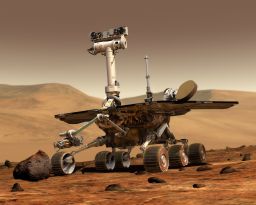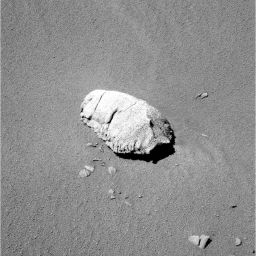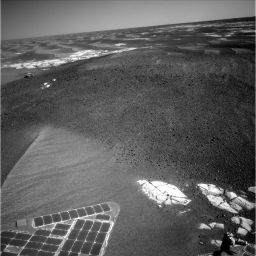A.J.S. Rayl • Jul 31, 2006
Mars Exploration Rovers Update: Spirit Completes Mission's Grandest Panorama, Opportunity Approaches Beagle Crater
The Mars Exploration Rovers (MER) are working right through the depths of the winter at their respective locations in Gusev Crater and Meridiani Planum. Although the twin robot field geologists are putting in short days and taking quality time to recharge, they still have team members marveling over their latest Martian finds.
The weak winter Sun is causing the solar-powered MER rovers, especially Spirit, to have less energy these days, but winter solstice -- the shortest day of the Martian year -- is coming up on August 8. After that, the Sun will begin rising higher in the Martian sky, and the weather in due course will warm up in Mars' southern hemisphere, giving both rovers access to more sunlight, and hence more power.
At Gusev Crater, Spirit is putting in about an hour's worth of work a day at its winter haven, Low Ridge, near McCool Hill in the Columbia Hills. Power has become enough of an issue that the rover has had to devote some days this month to simply recharging its batteries. Still, Spirit has been productive, essentially finishing the collection of images this month for the McMurdo pan, the largest, grandest, 360-degree panorama taken to date on the mission.
On the other side of the planet, Opportunity has continued its journey to Victoria crater, which at 800 meters (nearly half a mile) in diameter is the mother of all craters (at least as far as Opportunity is concerned), but took a slight detour toward the east to check out the much smaller Beagle crater, which is 35 meters (115-feet) in diameter. The rover is approaching this crater via an outcrop "trail," now called the Beagle Highway. It should pull up to the rim of Beagle sometime after the beginning of August.
Two and a half years after landing for a 90-day mission, "Spirit and Opportunity remain pretty healthy," reported Ray Arvidson, acting rover principal investigator, stepping up as Steve Squyres takes the family on vacation. In fact, Spirit celebrated its 900th sol this month. "That's 10 times beyond the primary mission lifetime," he pointed out in a recent interview. Opportunity will celebrate its 900th sol next month.
Despite the small amounts of sunlight reaching their arrays, the rovers are accomplishing a respectable amount of work. The power supplies determine, of course, how much work the rovers can do each sol. During the last month, Spirit's levels have dipped to 280 watt-hours, almost as low as the team anticipates they will go. Opportunity, which is on the other side of the planet but a little closer to the equator, has been able to access more energy, and apparently to lost some of the dust accumulation on its solar arrays; consequently, its levels have not really dipped below 400 watt-hours.
The instruments on both rovers' also continue to hold up well. Opportunity is still experiencing some issues with its Mössbauer spectrometer -- the reference channel on the device began exhibiting intermittent behavior last month -- but so far the glitching has not impacted the data. That rover's instrument deployment device (IDD), which had been cause for some concern in past months, has been functioning just fine of late. The grinder on Spirit's rock abrasion tool (RAT) is still gone for good, but the rover is using the brush on the instrument, and, in fact, used it quite a lot this month.
Spirit and Opportunity received new flight software this month and both rovers have completed the process of assembling and installing it. Version R9.2 will upgrade the rovers' capabilities, improving their capacity to autonomously drive and take IDD measurements on rocks post drives. It will also give them the capability of looking at transient phenomena, such as clouds and dust devils, in a more "economical" way, by zooming in on the one section of an image that changes and imaging only that while keeping the same general background.
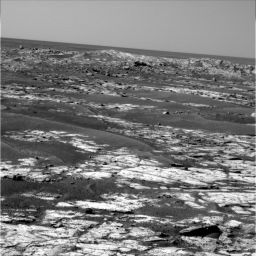 Beagle on the horizon
Beagle on the horizonOpportunity took this raw image on its approach to Beagle crater. It clearly shows the far rim of the crater, in the middle of the image just below the horizon, with the near wall distinguishable in the middle of the frame. The rover snapped this picture with its PanCam, using filter 2 (754 nm) on Sol 884 (July 20, 2006) at approximately 14:02:19 Mars local solar time.Credit: NASA / JPL / Cornell / USGS
"All the pieces of the new flight software have been put together into one unit and saved to EEPROM, the memory storage, on both rovers," said Joy Crisp, a rover science team member. [Formerly the MER project scientist, Crisp is currently 1 of the 2 deputy project scientists on the Mars Science Laboratory (MSL) mission, slated to launch and land in 2009.] An EEPROM, aka E2PROM, stands for Electrically Erasable Programmable Read-Only Memory, which is a storage chip used in computers and other devices to store data. The team plans to have the rovers "reboot" into the new software probably in August. "We definitely want to [reboot] before conjunction," noted Crisp, "which occurs around October 18-29, when Mars passes on other side of the Sun."
Even new software, however, probably won't change the personalities that have emerged from these twin roving machines. Opportunity remains "the glamour girl" who continues to claim the spotlight and most of the luck, as Spirit, "the more sober, older sister," is left as she has been since Opportunity landed, with the tougher road to travel. Just recently, for example, the team watched as Spirit's solar arrays have gotten dustier and dirtier while Opportunity apparently experienced an unexpected cleaning event. At least that's what Opportunity's upward trend in power and the models would seem to indicate, according to Crisp. The spring season, when dust devils and gusts of wind proliferate across the planet, is still a few months away, so the sudden cleansing came as a surprise. But that's okay, said Crisp. "There's a lot we don't know about Mars," she reminded. "We'll take any pleasant surprises we can get."
In related MER news, scientists from the NASA rover mission and from the European Space Agency's Mars Express OMEGA team got together last month in Venice, Italy to talk about the rover findings and how they match up with what OMEGA has seen from above, Arvidson said. OMEGA is the spectral imager on Mars Express that earlier this year found evidence that Mars has undergone 3 distinct geologic eras since forming some 4.5 billion years ago, only the first of which -- dubbed the phyllosian -- might have boasted large bodies of water that then dried up relatively quickly, within half a billion years or so.
"The workshop basically confirmed the idea put forth by OMEGA earlier this year that the phylosilicates or clay minerals seemed to have formed very early, because we don't see them at our 2 landing sites -- but we don't have the oldest rocks there," said Arvidson, who is deputy principal investigator on MER as well as an OMEGA team member. Arvidson, actually, has spent a lot of time on Mars. He held the title of team leader for the Viking Lander Imaging Team from 1977-1982, and is currently also serving as co-investigator, archiving lead for the Phoenix lander mission, in addition to his responsibilities as the James S. McDonnell Distinguished University Professor of Earth and Planetary Sciences at Washington University in St. Louis.
Even more enlightening correlations are likely to come from the Mars Reconnaissance Orbiter (MRO). Actually, Arvidson said, what Mars planetary scientists are waiting for now is for the Compact Reconnaissance Imaging Spectrometer for Mars (CRISM) -- the hyper-spectral imager on MRO -- to "pop its cover" on September 26. A visible-infrared hyper-spectral mapper, CRISM will search for mineral residues of water on the Martian surface and seek evidence of aqueous and hydrothermal deposits, as well as map the geology, composition, and layering of surface features. At the same time, it will monitor the patterns and density of dust and ice clouds. CRISM is much like OMEGA, "but with a much finer spatial resolution and a much finer sampling spectrally," Arvidson pointed out. "It's the shorter wavelength that's telling us the new story, relative to the thermal emission spectrometer (TES) [onboard Mars Global Surveyor]. For example, CRISM has a capability of acquiring images at 18 meters per pixel, and the smallest that OMEGA can see is 400 meters and usually bigger."
Spirit from Gusev Crater
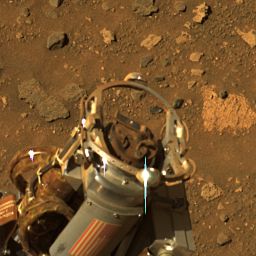 A dirty RAT
A dirty RATDuring recent soil-brushing experiments, the rock abrasion tool (RAT) on Spirit became covered with dust. Investigators were using the RAT to uncover successive layers of soil in an attempt to reveal near-surface stratigraphy. Afterward, remnant dirt clods were visible on both the bit and the brush of the tool. An abundance of iron oxide minerals in the dust gave the device a reddish-brown veneer. The rover acquired this approximately true-color image with the PanCam on Sol 893 (July 8, 2006). The image combines exposures taken through three of the camera's 13 filters.Credit: NASA / JPL-Caltech / Cornell
Spirit may be lacking energy, but this rover has never lacked the asset for which it was named. As June gave way to July, the rover's energy was around 285 watt hours and in recent days has dropped as low as 280, allowing it just enough power to carry out one major activity per sol. Not long into the month, Spirit had to begin spending some sols just recharging its batteries. "We'll bottom out in a couple of weeks, probably dipping to around 275 watt-hours, then start coming back up," Arvidson said.
The lethargy has taken something of toll on science team members, Crisp said. "It is hard. It's the psychological thing of each day you get less and less and we haven't even gotten to the solstice. We've kind of gotten used to this new routine though, and we tend to plan multiple sols – 2 or 3 sols at a time."
Despite the power issue, Spirit continued to make progress on its winter science campaign at Low Haven. During the first week of the month, the rover collected remote images and thermal readings of the sky and ground with its mini-thermal emission spectrometer (mini-TES), calibrated various instruments including its high-gain antenna and rock abrasion tool (RAT), as well as acquired more images for the gigantic McMurdo Panorama with the panoramic camera (PanCam), and took in new flight software files.
While Americans were celebrating July 4th -- Independence Day -- Spirit was hanging with Halley, using its Mössbauer spectrometer to further study the target of "loose, broken up rock," as Squyres described it last month. Halley is where the rover uncovered calcium sulfates, another indicator of past water, and the first calcium found in Gusev Crater.
By the second week in July, Spirit's power dropped to 280 watt-hours. Still, the rover managed to acquire images of a dark rock called Orcadas and more images for the McMurdo pan with the PanCam. On Sol 900 (July 15, 2006) the rover celebrated the milestone of being "alive and well" 10 times longer than the warranty by monitoring dust with the PanCam, and scrutinizing Halley with the alpha particle X-ray spectrometer (APXS).
In PanCam and hazard avoidance camera images that Spirit sent home, however, the ground team discovered a small clod of dirt lodged in the RAT, which they thought may be interfering with the operation of the instrument. Designers of the RAT at Honeybee Robotics and engineers at JPL developed a plan to run the brush in reverse to dislodge the dirt and, theoretically, return the tool to normal operation. On Sol 904 (July 19, 2006), Spirit executed the command. After running the motor backward for three seconds at three different voltages -- 5 volts, 8 volts, and 10 volts – the engineers then ran the motor forward, "and it was just fine," said Crisp. Either it never had a problem or the maneuver dislodged whatever was stuck beneath the bit. The RAT, meanwhile, is back to normal operations. "We're just not going to try and RAT soil anymore," Arvidson said. "Those little 2-3 millimeter particles in the soil that we can't see as we brush away the soil can jam the RAT."
Spirit, meanwhile, had turned its attentions to a laminated patch named Palmer, and collecting more images for the McMurdo pan. The rover continued collecting images for the really big panorama last week, as well as re-examining the rock Halley Brunt with its microscopic imager (MI), taking atmospheric measurements with the mini-TES, and testing all 200 pieces of the new flight software package it had received during the past couple of weeks.
By the middle of last week, Spirit had finished "building" its new flight software, a process that involves assembling, validating, and saving the many thousands of lines of computer code sent up from Earth, and over the weekend, the rover completed the McMurdo pan. "There may be a couple of other non-standard frames we want to fit in," Arvidson said, but essentially it's done.
In coming days, Spirit will be looking up more often. "We'll continue to look at the surface, but we're going to be putting a little more emphasis into atmospheric observation," Arvidson said. "We want to track the dynamics of the atmosphere as we go right into the depths of the winter and then come back out. That means looking with mini-TES at different elevations above the surface and characterizing the sky, and searching for clouds, and all sorts of other measurements that continue the overall campaign, but give a little bit more emphasis to atmospheric dynamics," he explained.
With the McMurdo pan complete, and once the Martian winter solstice is over, the science team plans to have Spirit change position. "There's no reason to stay where we are exactly and every reason to rotate the vehicle a little bit so there are new soils and rocks in the work volume for the IDD, said Arvidson. The rover's first turn "will probably happen soon after we pass through the solstice, around mid-August." Spirit will make the turn inch-by-inch, step-by-step, to make sure it doesn't lose any tilt. "That tilt to the north to catch the Sun is beaucoups important," Arvidson reminded.
At this point, which way Spirit will turn is anyone's guess. "We're still debating whether to go counter-clockwise or clockwise and there are good reasons to do both," Arvidson said. "If we go clockwise, we'll get more of the wheel tracks, and some very thin 'platey' rock exposures. Counterclockwise would get these bright bits of soil that a couple of people are interested in and Halley would be more centered in the work volume. But we're still debating." Before Spirit leaves Low Haven, he added, it will probably rotate a number of times to get new targets in the work volume for the IDD, so chances are that everything that must be seen will be seen.
Opportunity from Meridiani Planum
At Meridiani Planum, Opportunity greeted July by assessing the tau-- measuring, in effect, the opacity of the atmosphere -- and remote sensing its surroundings with the mini-TES. The rover focused this month, much as it did the last, driving toward Victoria crater, veering slightly off course in recent days to make an intermediate stop at Beagle crater. Named for the HMS Beagle, Charles Darwin's ship, and ESA's Beagle 2 lander that didn't make it to Mars in one piece, this smaller crater is on the edge of the ejecta plain emanating from Victoria, which is still another 500 meters or so further to the south.
During the first week of the month, Opportunity, like its twin, took in hundreds of pieces of the new flight software, but this robot geologist got to celebrate Independence Day by roving. It completed 3 successful drives toward Victoria on Sols 869, 870, and 871 (July 4, 5, 6, 2006), homing in along the way on targets called Austin, McKinney, Baxter Springs, and Ft. Gibson with its PanCam. The rover also took another tau with the PanCam, used the mini-TES to take thermal measurements of the ground and sky, and of McKinney, and completed a calibration of the mini-TES's elevation actuator or motor to remove any "drift" that happens naturally with use.
In order to get to Beagle, Opportunity had to divert its course to the east and that meant it had to cross a ripple. On Sol 873 (July 8, 2006), the rover began the crossing, but stopped the drive prematurely because it was slipping by 80% and determined it was making too little progress. Instead, the rover filled out its day by doing some dust monitoring with the PanCam mast assembly (basically, its head and neck), and conducting some morning atmospheric science, including a sky and ground observation with the mini-TES. On the following sol, the rover used the PanCam to survey the ground and take thumb-nail images of the sky, and also took pictures with its navigation camera in order to determine where to point the mini-TES, which was then used to take measurements of the sky and ground. By Sol 875 (July 10, 2006) Opportunity was able to successfully back away from the ripple. It then took a few moments to check out yet another potential meteorite in the distance with its PanCam and mini-TES.
 Red Rock
Red RockOpportunity had to stop to take an image of this odd-looking target, dubbed Red Rock, as it was roving to Beagle crater. Using the PanCam, filter 3 (673 nm), the rover snapped this picture on Sol 881 (July 16, 2006) at approximately 12:18:52 Mars local solar time.Credit: NASA / JPL / Cornell / USGS
On Sol 876, Opportunity drove in a southwesterly direction toward to the edge of another ripple about 15 meters (49 feet) away, to determine whether the outcrop adjacent to it was reachable and whether there was a traversable path from that outcrop to Beagle crater. It looked good and so the following sol, the rover drove about 25 meters (82 feet) toward that outcrop "trail,' putting Opportunity within 140 meters (459 feet) of Beagle crater and on "a vast expanse that we now call the Beagle Highway," confirmed engineer Scott Maxwell, one of the rover drivers at JPL.
"This extended patch of outcrop is something we drove toward in the hopes it would turn out to be what we had hoped it would be, which is more highway and fewer speed bumps on the way to Beagle crater -- and it is," Maxwell said. Since the Beagle Highway tends to go east-west, it allows the rover to pick up considerable eastward distance toward the crater, "which normally has been something we could do only by climbing over these ripples, which is dangerous for us," he explained. Opportunity – and Maxwell and the other rover handlers -- learned that the hard way -- twice.
After the drive on Sol 877, the rover did some remote sensing with the PanCam and mini-TES, as well as a "quick find attitude" check at the end of the drive, a procedure that updates the rover's physical position. In the days that followed, Opportunity studied several soil samples up close, including: Westport, a sample without any spherules, to give the science team members a soil sample from just outside the dark ring or annulus around Victoria; Dallas, a disturbed patch in the tracks intended to be similar to spot the rover examined with the spectrometers; and Fort Graham, an undisturbed soil target. The rover also checked out a raised patch of outcrop dubbed Waco with the PanCam.
Using the mini-TES, Opportunity discovered what appear to be ejecta blocks, which they promptly dubbed Preston and Red Rock. The bizarre, crustacean-like appearance of these rocks reminds observers of just how alien Mars can be. On Sol 883, 884 (July 19, 20, 2006), the rover continued its drive to the south corner of Beagle, bypassing it a bit and backtracking to the northeast, to get onto the Beagle Highway, "which we can see from orbital images," said Crisp.
Along the way, the rover used its navigation camera to take a picture of an odd-looking Martian mound, which the team nicknamed Jesse Chisholm. The science team members instructed the rover to stop and spend some quality time examining this Martian oddity with the instruments on the IDD. "We don't know what it is,' said Crisp. "It's covered with pebble-sized rock fragments – and it certainly stands out as something new out here something we haven't seen out here on the Meridiani plains," she added. "We made measurements with the IDD, and took long observations with the Mössbauer spectrometer, so we'll see."
Opportunity should be at the rim of Beagle crater "in another drive or two," Maxwell said. As close as he rover is to the intermediate stop, however, there's no real rush to get there. "We are crossing this transition zone, from the kind of terrain we've been in to the kind of terrain around Victoria, the dark, ring around the crater we now call the Victoria Annulus," Maxwell explained. "The scientists want to do some last observations of the area we're in before we get into this other stuff so they can compare the two." That means the rover will probably "stand down" for a few days as it has a couple times in last few weeks, "to use the IDD to sample the material around us before we really go all the way to Beagle."
"We are interested in comparing the soil before we get to the Victoria Annulus and after we get to the Annulus," confirmed Crisp. "The science team would also like to look at some of the banding in the sand ripples, and we're going to be seeing a lot more of the rock outcropping as we approach Beagle, so we may want to stop and check things out."
While the discussions and debates about which direction to go and what to examine up close are ongoing, there is a general plan, Arvidson said. "Beagle crater features ejecta rays [areas of ejecta that look like rays in the orbital images], so we'll explore some of those first, then we'll climb onto the ejecta apron or annulus of Victoria and drive across toward the northwest portion of Victoria. We want to characterize the broad, dark apron [the Annulus] that extends out around the rim of Victoria, because it's very peculiar, very homogenous when seen from orbit, and we're not exactly sure what it is." Nor do they know what it will take to cross it.
"What we've been hoping for, crossing our fingers for, is that we would get to the Annulus and it would be this very flat material similar to what we had around Eagle and it would just be smooth driving," Maxwell offered. Recent high- resolution images, however, indicate the Victoria Annulus may be more similar to the stuff Opportunity has been navigating through. "So we're not sure that will turn out to be as friendly to us as we thought," he said. Whether it is or not, the rover drivers have no fear and a lot of confidence. "We've been driving for kilometers in this stuff and we know this material very well," Maxwell said. "It's not going to keep us from getting to Victoria that's for sure."
That's no idle boast. The rover handlers have learned a thing or two about roving on Mars in the last two and a half years. From Opportunity getting stuck in and emerging from Purgatory Dune, for example, they learned that the 2 sides of the ripple walls, which the rover has been crossing over for months on the way to Victoria, are not the same. "The wind blows in from the northwest to the southeast and it's carrying with it this fine dust that builds up on one side of the ripples, and on the other side it's more gravel-like material," Maxwell explained. The side with the "fluffy layer" of fine dust is what can – and did -- stop a rover in its tracks. They know that now and have adopted a new set of precautions. "That's why we call this exploration – because we learn this stuff," noted Maxwell, who admits that as a rover driver he has "the best job in 2 worlds."
Opportunity, always "the glamour girl," promises to reveal more ancient Martian history and long-held Martian secrets this fall as it pulls up to Victoria, and goes farther back in Martian time, layer by layer. "The neat thing is we'll be characterizing the interior of Victoria before we drive in, and at about the same time that MRO starts its operations," said Arvidson. The possibilities for collaboration are as obvious as they are exciting, so, not surprisingly, MER science team members are currently working with MRO's CRISM and High Resolution Imaging Science Experiment (HiRISE) team members, "putting together ideas for joint operations," said Arvidson. "We should be able to see the rovers on the ground and the outline of the vehicles with HiRISE, and with CRISM we'll be able to see the layers in the walls to Victoria crater that Opportunity will rove across and characterize."
Support our core enterprises
Your support powers our mission to explore worlds, find life, and defend Earth. You make all the difference when you make a gift. Give today!
Donate

 Explore Worlds
Explore Worlds Find Life
Find Life Defend Earth
Defend Earth


